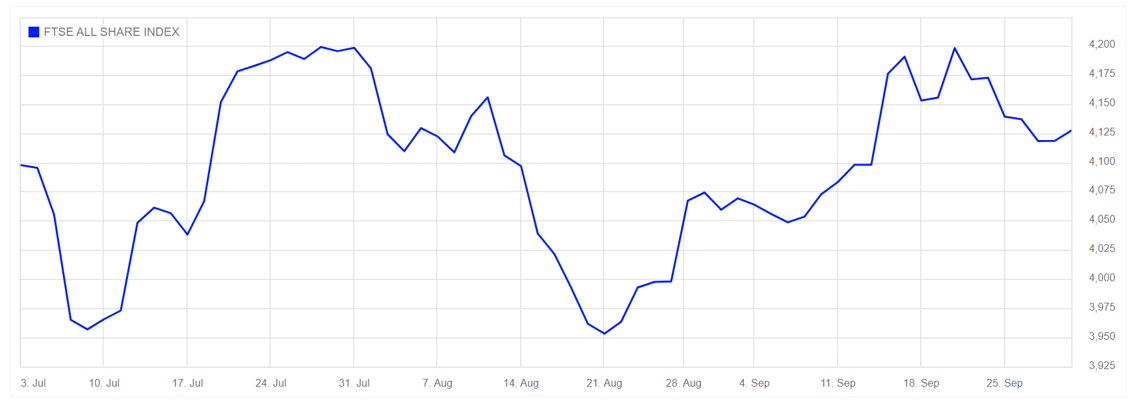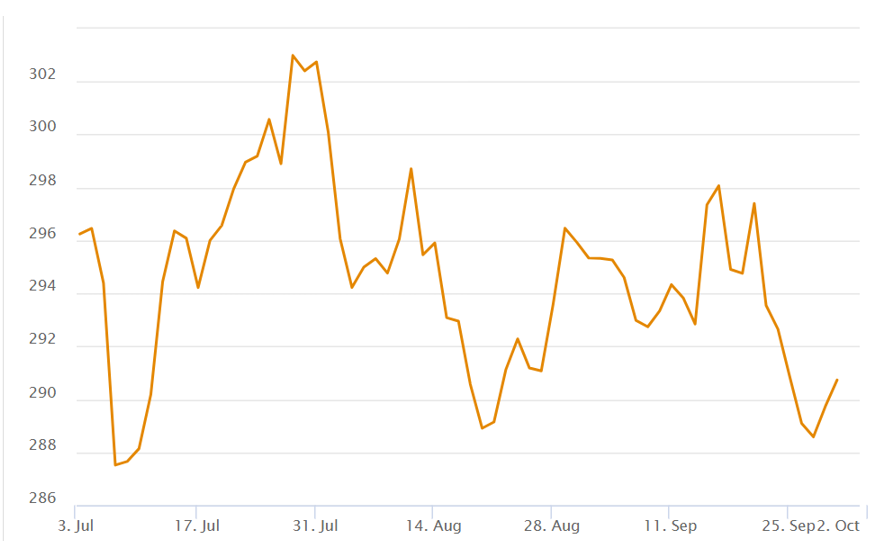While inflation rates dipped slightly in many of the G7 countries in the third quarter, high interest rates and an increase in borrowing costs meant that many of these economies faced a difficult few months.
Across the globe, the developing and emerging economies were the primary drivers of the global economy in Q3, helped by increased investment, tourism, and rebounding domestic activity.
In Europe, there was a subdued growth environment in the third quarter, mainly influenced by higher interest rates. Similarly, China’s financial recovery lost some momentum.
So, read on to discover how the UK, European, US, and Asian markets performed between July 2023 and September 2023, and some factors contributing to their performance.
UK
While the UK inflation rate fell in Q3, it still remained high, with the Consumer Prices Index (CPI) only dropping to 6.7% in August. In a bid to further combat inflation, the Bank of England (BoE) raised interest rates, increasing the base rate by 0.25 percentage points to 5.25%.
The BoE’s Monetary Policy Committee (MPC) expects the UK inflation rate to fall further to around 5% later in 2023 and meet its 2% target by early 2025.
While inflation remained relatively high, the Office for National Statistics revealed in August that the employment rate had decreased very slightly, dropping to 75.7% between April and June 2023. Similarly, the unemployment rate was 4.2%, up 0.4% from the previous quarter.
As the below graph highlights, UK equities gained in Q3, with the FTSE All-Share beginning July at 4,097.65 and ending September at 4,206.71.

Source: London Stock Exchange
Europe
The annual inflation rate in the Eurozone remained steady at 5.3% in August 2023, decreasing from 6.1% in May. However, this was still more than two times above the European Central Bank (ECB) goal.
As the inflation rate remained above target across the Eurozone, the ECB introduced a further 0.25 percentage point increase in interest rates, with the deposit rate rising to 3.75% on 2 August.
Additionally, as you can see from the graph below, the MSCI European Index fell across the quarter, potentially influenced by the banking sector after the Italian government announced a tax on banks’ “excess” profits.

Source: MSCI Europe
US
Due to higher food and energy prices, the US’s inflation rate increased to 3.7% in August, up from 3.2% in July.
With inflation rates still relatively high, the Federal Reserve increased interest rates to 5.25% in July, the highest in 22 years. That came after 11 consecutive rate rises since early 2022.
The US Federal Reserve chairman, Jerome Powell, stated that they were prepared to raise rates further if appropriate but that “the Fed would proceed carefully”, with food and energy prices remaining volatile.
At the start of August, the credit rating agency Fitch downgraded the US government’s credit rating from AAA to AA+, citing increased political dysfunction and unsustainable debt and deficit trajectories.
In Q3, unemployment numbers dropped to 3.5%, while average hourly earnings were slightly stronger than previously expected, at 4.4% year-on-year. Retail sales also increased 0.7% month on month in July, which was above expectations of a 0.4% rise.
Although the US economy remained relatively strong, equities declined in the last two months of the quarter. This was the first quarterly decline since Q3 in 2022. In fact, the S&P 500 started July at 4,455.58, before falling to 4,288.04 at the end of September – an overall quarterly decline of 3.7%.
Asia
In China, the CPI turned negative in July, at -0.3% year-on-year, while producer price index (PPI) deflation continued for the 10th month in a row.
As a result, the People’s Bank of China lowered its interest rate twice in August, reaching 3.45%.
To try and address economic difficulties, there were also some initiatives taken to try and support financial markets, including halving the Stamp Duty on stock trading.
Japan’s economic growth was expected to slow down in Q3, with Now-Casting Economics projecting growth of just 0.75% quarter-on-quarter. This would be a deceleration from the 1.5% quarter-on-quarter growth in Q2.
Compared to other markets, Japanese equities stayed relatively strong in the third quarter, starting July at 2,322.56 and ending September at 2,323.39 – a small gain of 0.41%.
Get in touch
If you need advice on any aspect of our Q3 investment update, please get in touch. Email admin@stonegatewealth.co.uk or call 01785 876222.
Please note
This blog is for general information only and does not constitute advice. The information is aimed at retail clients only.
The value of your investment can go down as well as up and you may not get back the full amount you invested. Past performance is not a reliable indicator of future performance.


 Production
Production
